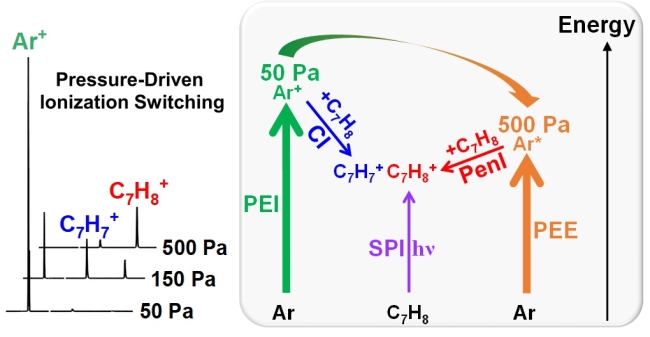Recently, a research group led by Prof. LI Haiyang and Prof. HUA Lei from the Dalian Institute of Chemical Physics (DICP) of the Chinese Academy of Sciences (CAS) has discovered a new phenomenon in pressure-driven switching of photoionization channel using a home-built time-of-flight mass spectrometer (TOFMS).
The study was published in Analytical Chemistry on Mar. 29.

Pressure-driven switching from photoelectron impact ionization-chemical ionization (PEI-CI) to Penning ionization (Image by YU Yi)
Vacuum ultraviolet photoionization (VUV-PI) is a soft ionization technique operating under pressures ranging from vacuum to ambient pressure. VUV-PI has played an essential role in direct sampling mass spectrometry.
In this study, the researchers have studied new ionization processes initiated by photoelectrons through the inclusion of a radio frequency (RF) electric field at different pressures. After deducting the contribution of single photoionization (SPI), they discovered that the signal intensity of 1 ppmv toluene (C7H8+) in Ar was approximately 5-fold higher than that in N2.
The researchers further investigated mixed gases with different ionization energies (IEs) and excitation energies. They revealed that metastable species were involved in the enhancement process. Reactant ions were produced by photoelectron impact ionization (PEI), which further triggered ion-molecule reactions, i.e., chemical ionization (CI). Metastable species were produced by photoelectron impact excitation (PEE), which further triggered Penning ionization (PenI).
Moreover, they indicated that analytes with IEs above 10.6 eV, such as CO2 (IE = 13.78 eV) and CHCl3 (IE = 11.37 eV), could be sensitively ionized by PenI with a sensitivity comparable to SPI. Except for the contribution of SPI, the dominant ionization process was switched from PEI-CI to PenI when the pressure was elevated from 50 to 500 Pa, as the electron energy gradually decreased and was only able to produce metastable states based on the kinetic energy balance equation of electrons.
"This study is helpful to develop new selective and sensitive VUV-PI sources and understand the ionization mechanism in other discharge ionization sources," said Prof. LI.
"The sensitivity of PenI could be further enhanced by employing VUV lamps with higher photon flux or photocathode material with higher quantum efficiency, which will result in higher density of photoelectron and produce more metastable atoms/molecules. High-pressure PenI initiated by photoelectron exhibits advantages of selectivity and sensitivity, which shows broad application prospects in the analysis of complicated samples," Prof. LI added.
This work was supported by the National Natural Science Foundation of China, the Scientific Instrument Developing Project of CAS, and the Innovation Research Foundation of DICP.